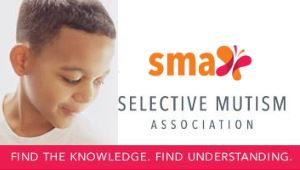Blog
Untangling Selective Mutism and Social Anxiety: Similarities, Differences, and Implications for Treatment
July 2025
Dear SMA Community,
Perhaps understandably, symptoms of Selective Mutism are often mis-labeled as Social Anxiety. It’s easy to see the similarities—in both conditions, the person impacted can freely and comfortably interact in some social situations, while avoiding (or enduring anxiety about) other social demands. In both conditions, the individual may experience difficulties carrying out the social interactions that are expected of them (e.g., contributing to a lesson at school, completing an interview to get a job) and/or that they want to be able to do (e.g., asserting their opinion, introducing themselves to someone new, dating). In both conditions, the individuals’ internal thoughts often reflect worries about others judging them, concerns about making mistakes, and/or feeling uncertain about what to say to effectively communicate their point (Vogel et al., 2019).
Research suggests that approximately 69% of individuals with SM also have Social Anxiety (Driessen et al., 2020). Though obviously, that means that 31% of individuals with SM do not also have Social Anxiety. Thus, while some experience anxiety about verbal demands (often resulting in their silence in social interactions) and nonverbal aspects of social interactions (e.g., making eye contact, being in the “center of attention,” eating/drinking in front of others, etc.), others exhibit surprisingly little anxiety about nonverbal social demands. These individuals may actively seek out attention by offering jokes (provided they can be delivered nonverbally) and may excel in performance scenarios (again, provided they can be completed nonverbally).
One key difference between the two conditions is when the symptoms typically emerge. Whereas social anxiety often first manifests in adolescence, SM is usually first apparent between the ages of 2-4 (Viana et al., 2009). Another key difference is that the diagnostic criteria states that individuals with Social Anxiety may be able to “endure” social situations “with intense anxiety” (American Psychiatric Association, 2022) while many with SM primarily avoid the anxiety-provoking situation altogether—by not speaking.
Identifying the appropriate diagnosis—or whether both are present—can be accomplished through a comprehensive diagnostic interview, behavioral questionnaires focused on anxiety and communication behaviors, and clinical observations. Providers should be careful, however, not to assume that a client “can’t have” SM even if they speak comfortably during an initial session, though this is clearly a scenario where both diagnoses should be on the table.
Another scenario which can be especially tricky to assess is when the individual with SM presents with a “low profile.” White and Bond (2022) described this presentation as one in which the person’s fear of disapproval outweighs the fear of speaking. They may respond to questions when it seems important to do so, in a short answer, using a quiet voice while generally not initiating speaking with people outside of their comfort zone.
Diagnostic specificity, however, is important in that it leads to treatment specificity. Exposure therapy (i.e., purposefully encountering anxiety-provoking stimuli in a slow and controlled manner) is central to evidence-based intervention for both conditions (and other anxiety conditions for that matter!). But there are also nuances in skill/strategy use that help a person engage in meaningful exposure to talking to new people and/or in new spaces that go beyond the more foundational exposure therapy prescription. That is, “we’ve identified that talking to your teacher is a great goal; let’s think about what to say and when is a good time to say it” wouldn’t be effective in the way that “we’ve identified that going to a restaurant alone is a great goal; now let’s look at your schedule to make it happen” might. That’s not to say that the either practice would be “easy” but often individuals with SM would need to initiate a social interaction (generally considered to be a hard goal) and have the communication partner’s awareness/collaboration as to how to phrase questions, to provide ample time for the person to respond, etc. Most of the set-up predicates on the client already being able to speak (e.g., “help me carry out this goal for myself. You should ask me ‘What did you do this weekend?’ but please only ask the question when it’s just us because it will be too difficult for me if there are others around”)…therein lying a significant problem. This problem, among others, can be solved by tailoring general exposure therapy techniques to SM specifically, as has been done in evidence-based approaches including Parent-Child Interaction Therapy for SM (PCIT-SM) and Social Communication Anxiety Treatment (S-CAT), and focusing on training others such as caregivers and school-based professionals on how to support exposure goals.
Sincerely,
Katelyn Reed, M.S., LLP
SMA President
References
American Psychiatric Association. (2022). Diagnostic and statistical manual of mental disorders (5th ed., text rev.). https://doi.org/10.1176/appi.books.9780890425787.
Driessen, J., Dirk Blom, J., Muris, P., Blashfield, R.K., & Molendijk, M.L., (2020). Anxiety in children with selective mutism: A meta-analysis. Child Psychiatry & Human Development, 51, 330-341.
Viana, G., Beidel, D., & Rabian, B. (2009). Selective mutism: a review and integration of the last 15 years. Clinical Psychology Review, 29 (1): 57–67.
Vogel, F., Gensthaler, A., Stahl, J., & Schwenck, C. (2019). Fears and fear-related cognitions in children with selective mutism. European Child and Adolescent Psychiatry, 28 (9), 1169-1181. doi: 10.1007/s00787-019-01281-0
White, J. & Bond, C. (2022). The role that schools hold in supporting young people with selective mutism: a systematic review. Journal of Research in Special Education Needs, 22 (3), 232-242. doi: 10.1111/1471-3802.12561




